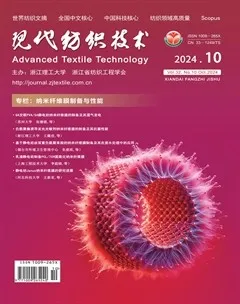基于衬纬组织电加热针织服装的制备及其电热性能
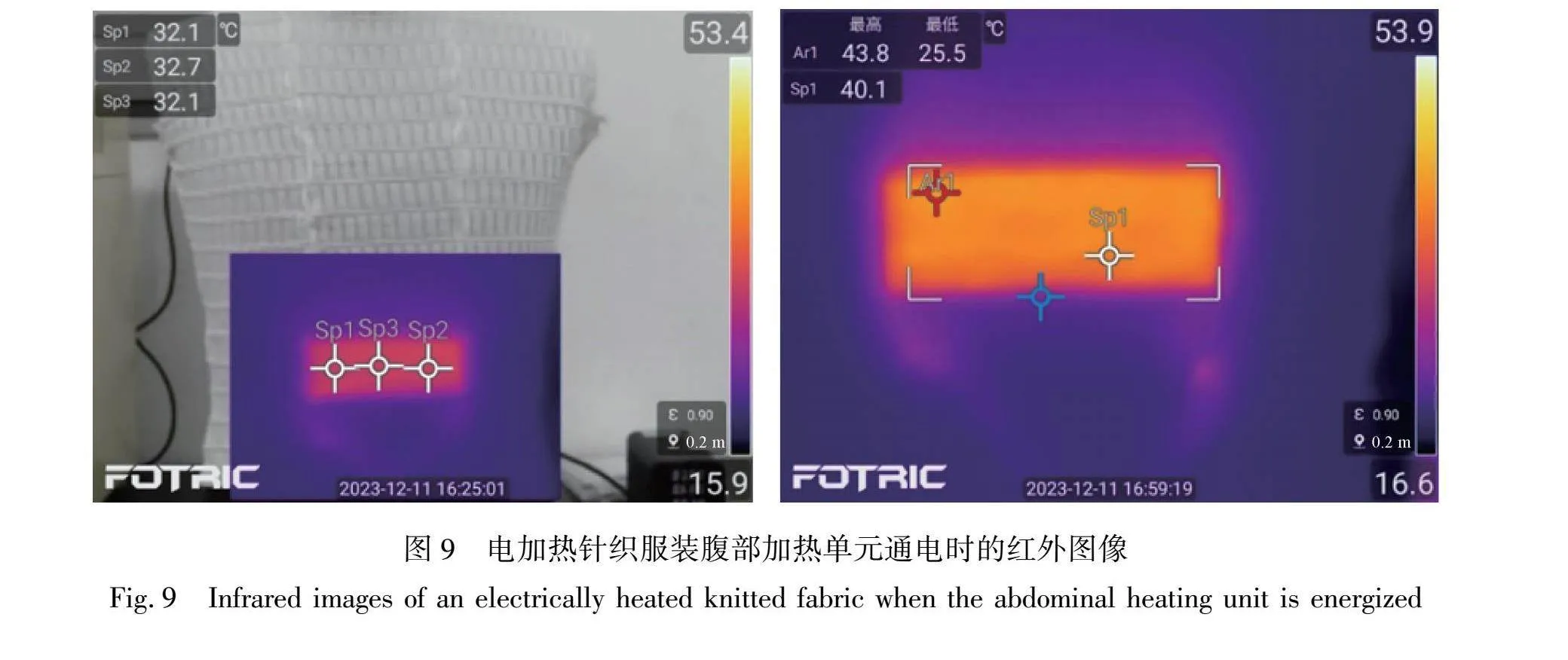


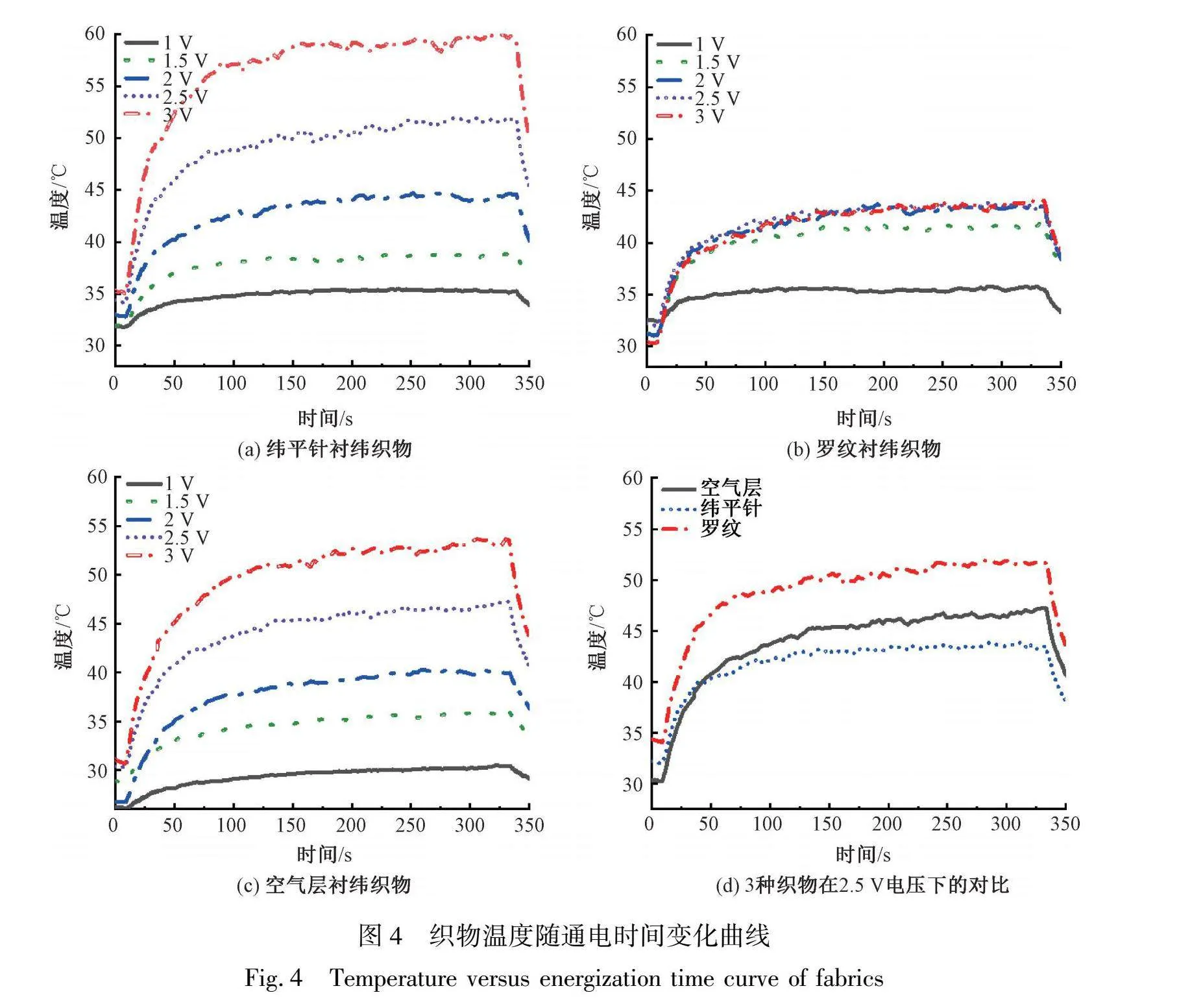
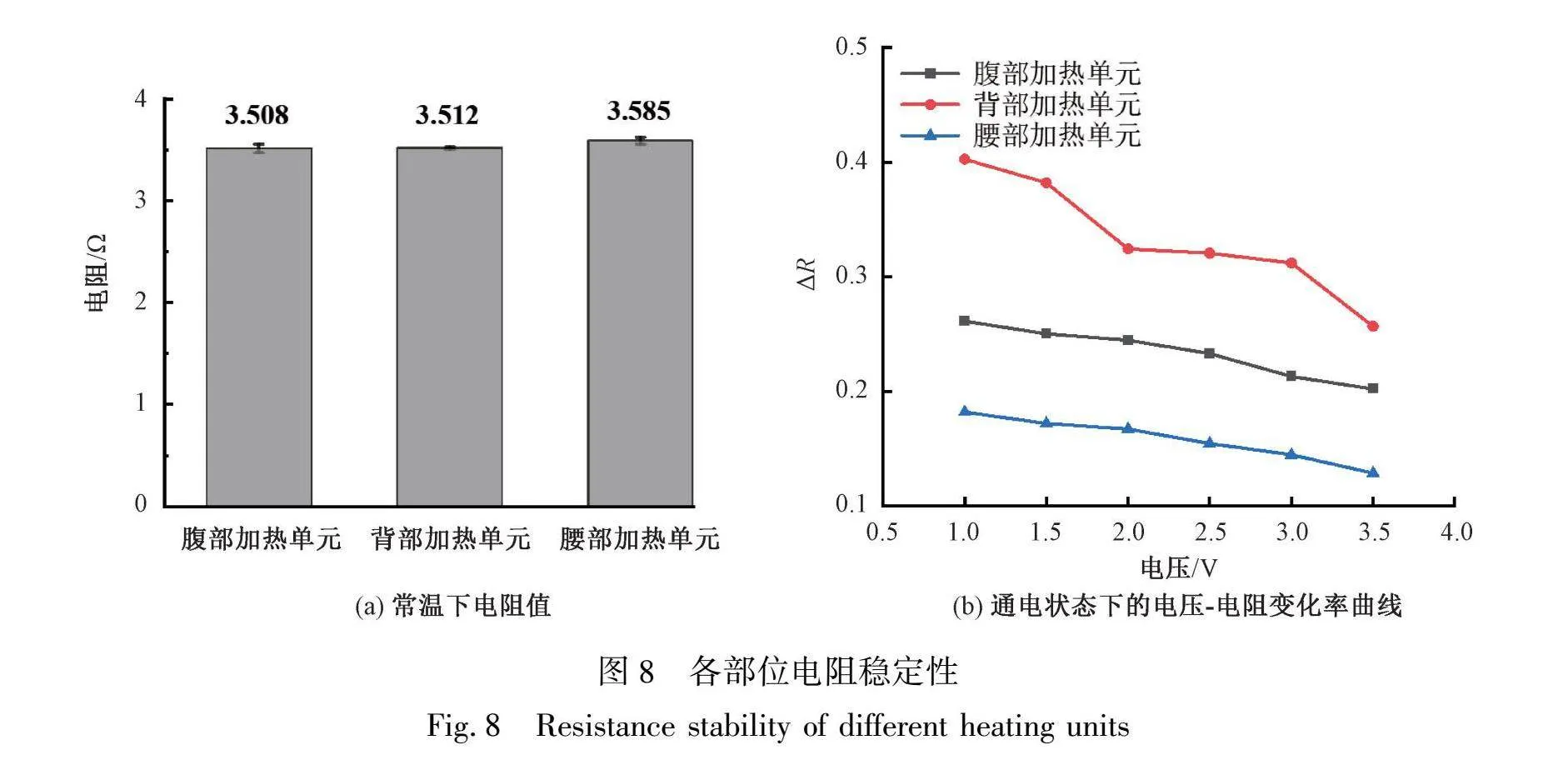
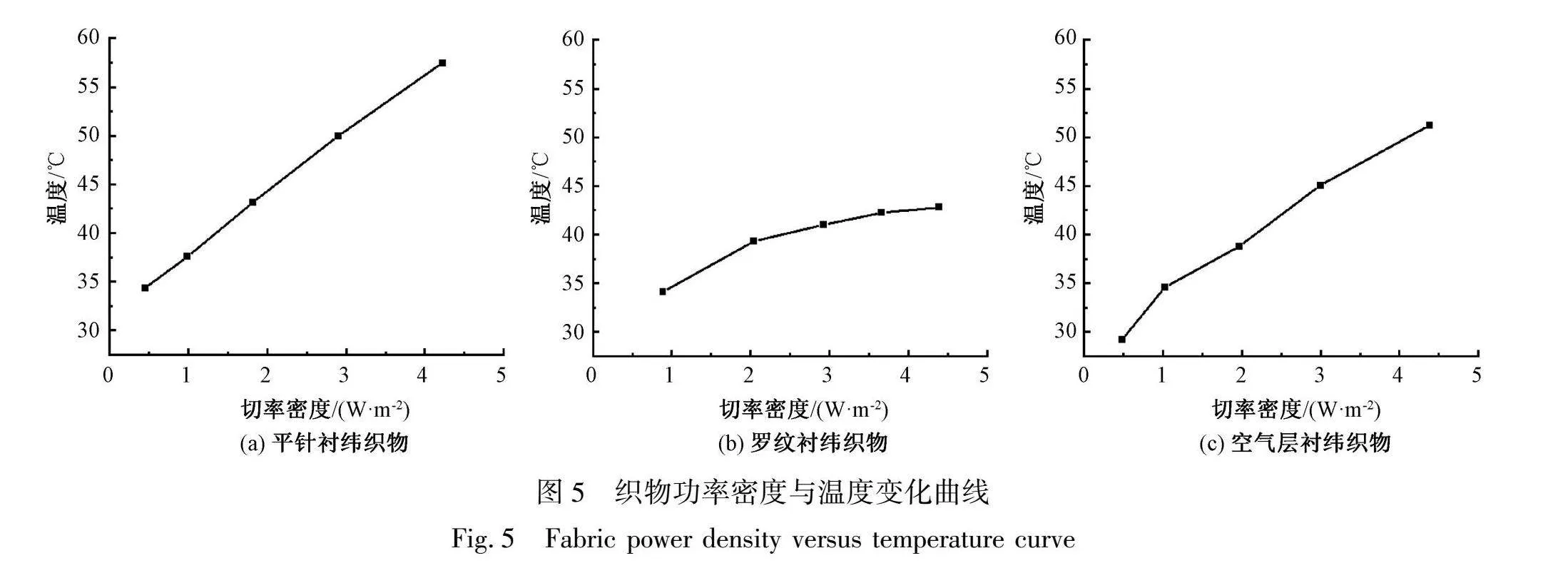
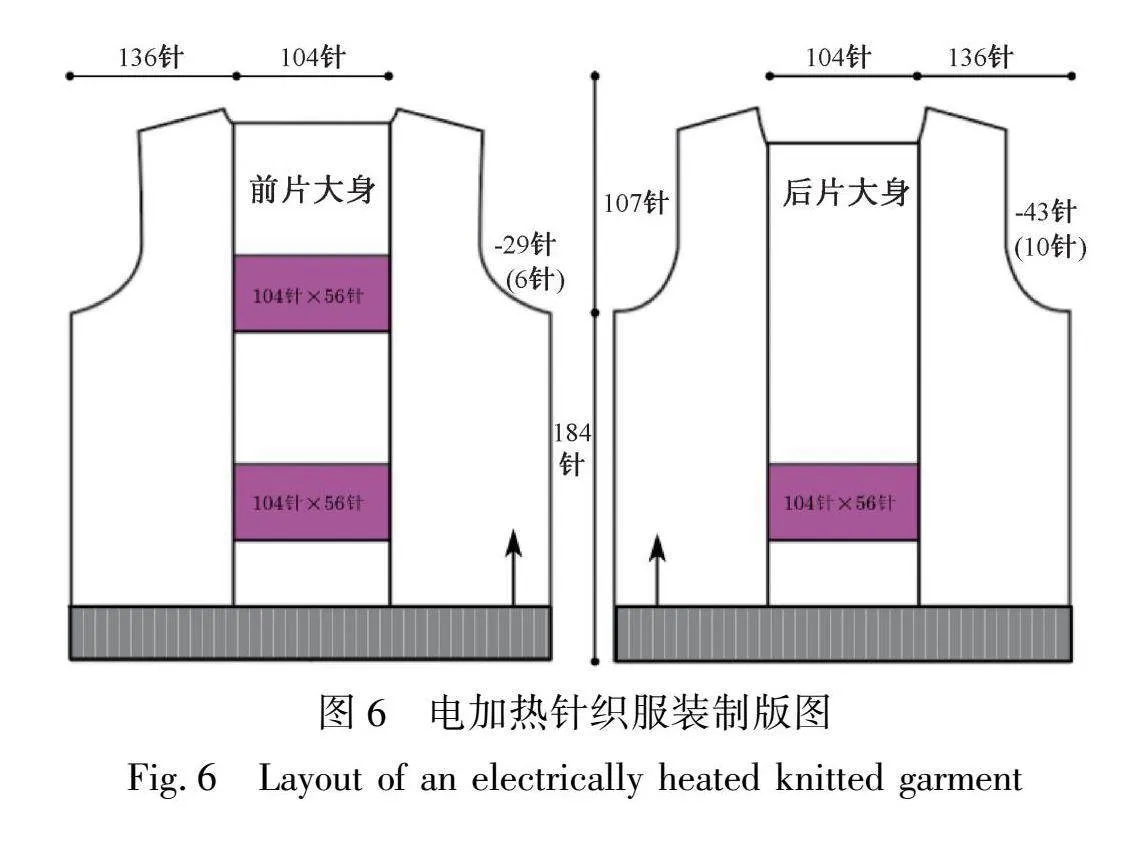
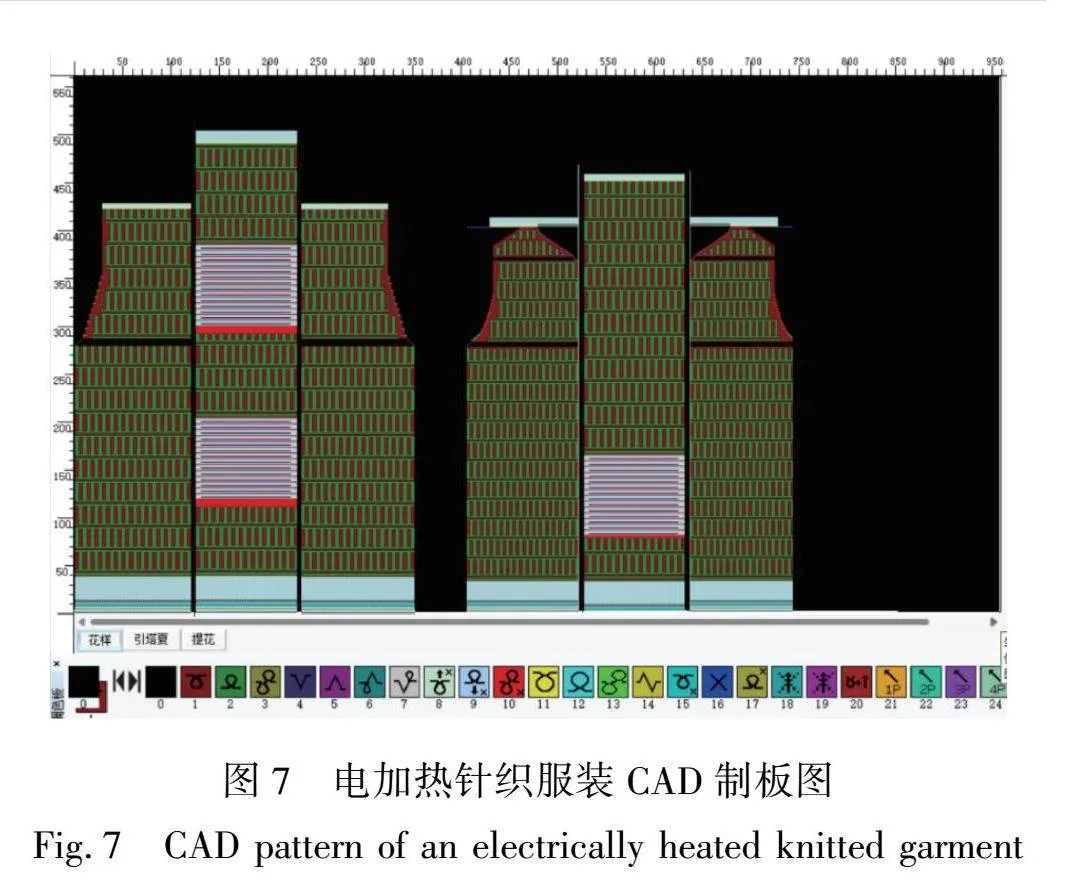
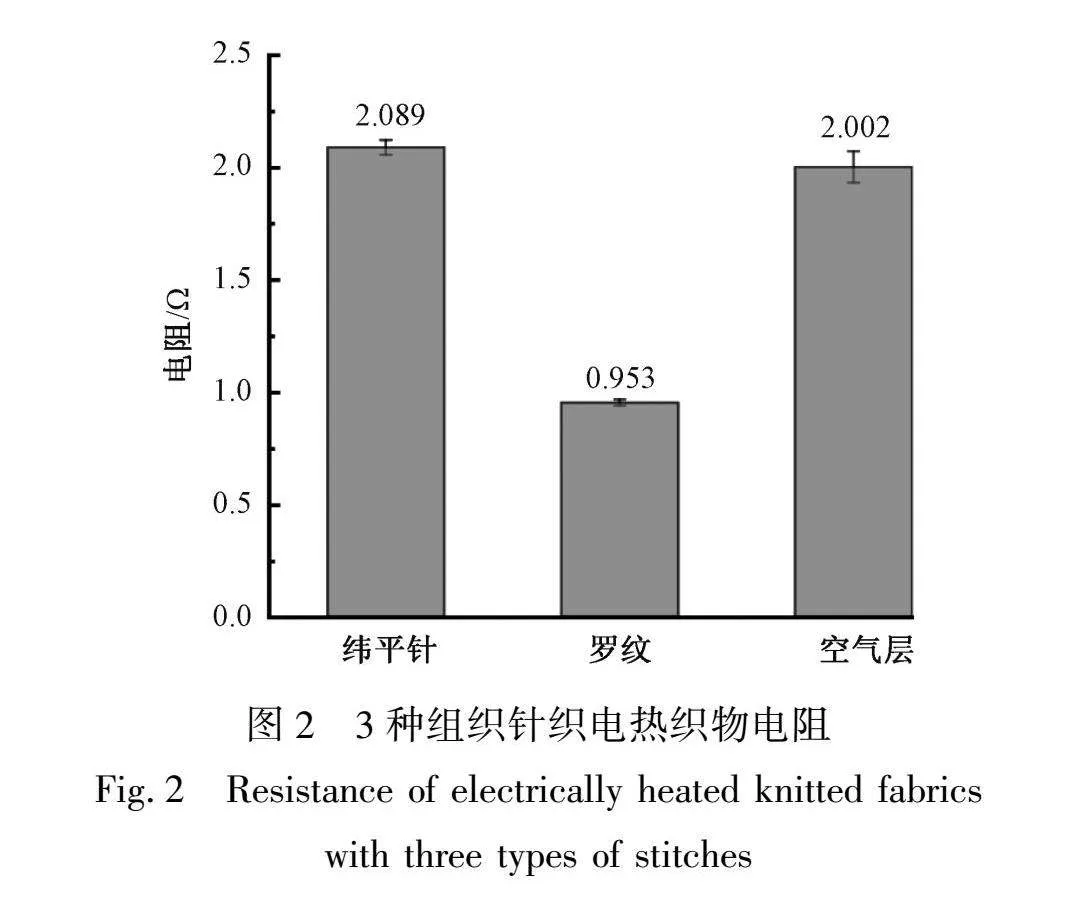
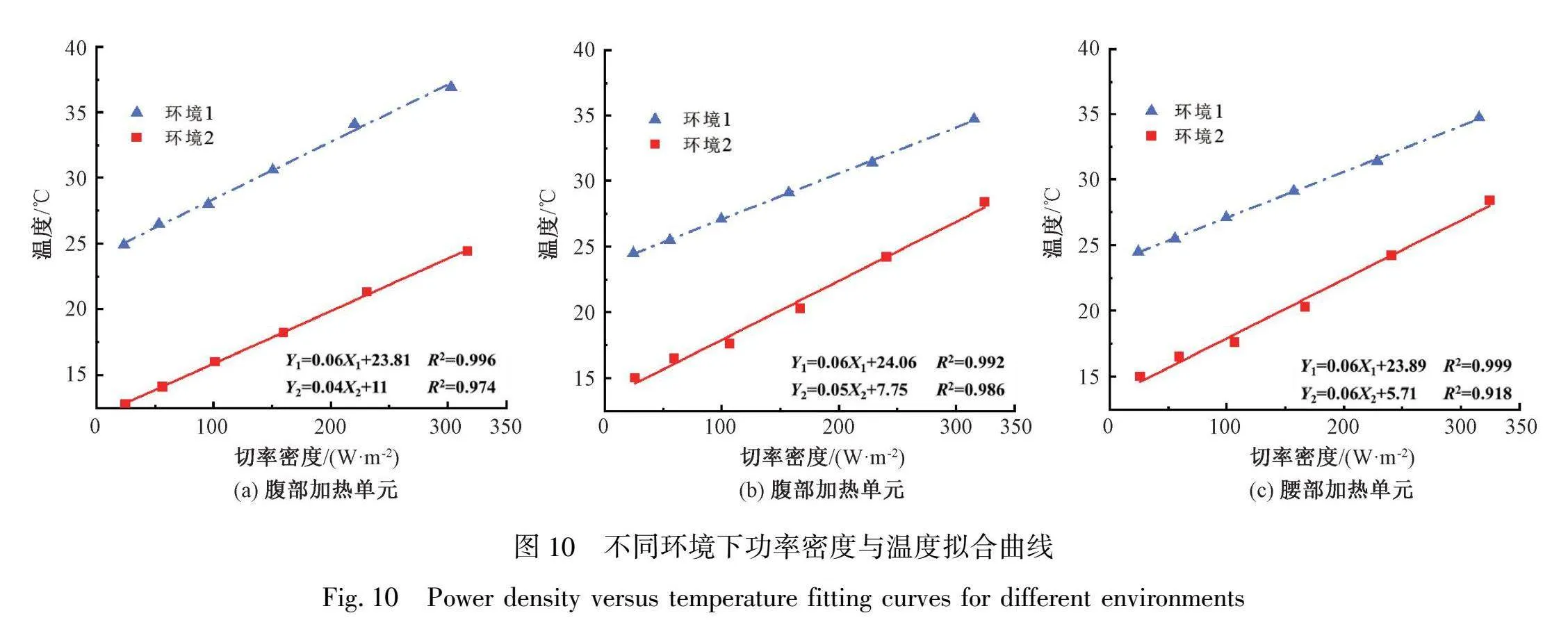
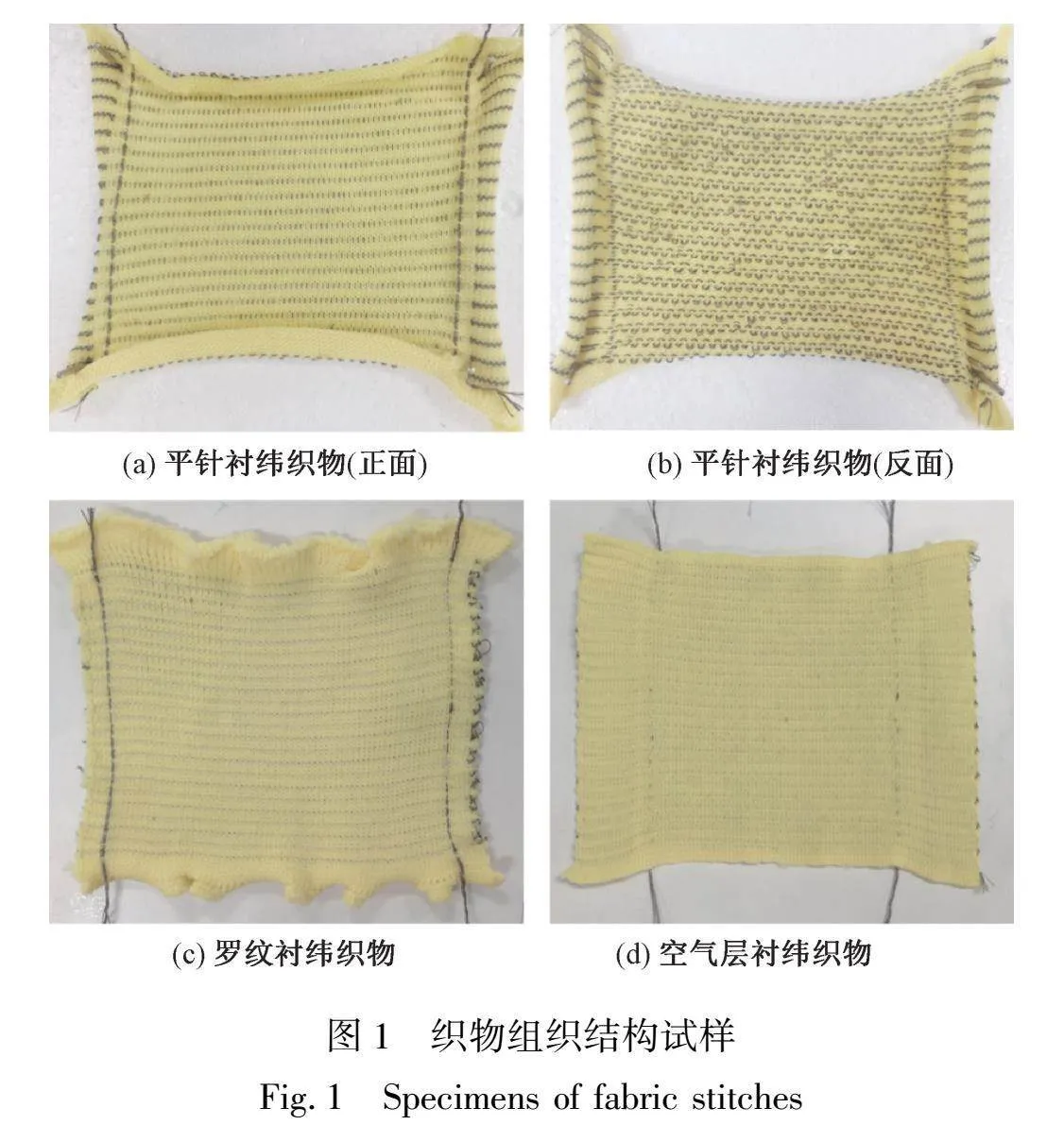
摘 要:为了拓展纬编衬纬组织在电加热针织服装上的应用,将镀银纱线作为衬纬纱线,均匀衬入纬编针织物中,织造3种不同组织的针织物并进行性能测试与分析。根据测试结果,选用结构最稳定、发热效果良好的空气层衬纬作为加热部位组织结构,设计并织造了一件电加热针织服装,同时进行发热性能测试。结果表明:在实验室温度为(20±2) ℃且额定电压为1.0~3.5 V的情况下,电加热针织服装的腹部加热单元的平衡温度由24.9 ℃逐渐升温至36.9 ℃;背部加热单元的平衡温度由25 ℃逐渐升温至35.9 ℃;腰部加热单元的平衡温度由24.5 ℃逐渐升温至34.7 ℃,各加热部位平衡温度均满足人体所需。该研究结果可为衬纬组织在电加热服装中的应用及市场开拓提供理论参考。
关键词:纬编衬纬组织;镀银纱线;电加热针织服装;热性能;平衡温度
中图分类号:TS184.5
文献标志码:A
文章编号:1009-265X(2024)10-0135-08
随着新型编织原料[1-2],针织设备电脑控制技术[3]和花型设计系统[4]的进一步应用,智能针织产品受到广泛的关注。采用纬编编织技术的智能针织品可以在织物的指定位置编织出不同形状、大小的智能化区域[5],使智能化产品的定制化程度更高。同时因其产品也具有轻便和美观的优势,国内外对智能电加热可穿戴技术的关注度较高[6],拥有巨大的市场潜力。衬纬针织结构是重要的织物设计元素,广泛应用于电加热针织服装服饰的设计与生产当中[7]。衬纬组织是在地组织基础上,沿纬向周期性地衬入一根或几根不成圈的辅助纱而形成的组织[8];纬编衬纬组织通过地组织的变化,和衬纬纱功能性的变化,可以赋予组织不同特性,纬纱的衬入可以改善和加强衬纬组织的性能,纬编衬纬组织可应用于开发智能化区域[9-10]。衬纬组织不仅在服装上有广泛应用,同时也应用于工业、医疗、和其他功能纺织品的结构设计中[11-12]。
本文使用镀银纱线为加热元件,以涤纶纱线为地组织纱线,使用电脑横机编织平针衬纬、罗纹衬纬、空气层衬纬3种组织结构的电加热针织物,研究其在不同负载电压下的电阻稳定性、电热性能,并选择一种合适的组织结构设计织造一件电加热针织服装,研究不同环境温度下加热服装的发热情况。为了讨论纬编衬纬组织在针织电加热服装上的应用,本文将电加热织物作为成衣的一部分衣片,优化电加热织物与服装的结合形式,研究电加热片在服装中不同部位的发热情况,以期为衬纬组织在服装中的应用提供参考。
1 实验
1.1 实验材料与仪器
镀银纱线(山东青岛亨通伟业特种织物公司),规格:28 tex;铜丝(台州市泰通电线电缆有限公司),规格:5.56 tex;涤纶纱线(潍坊冠杰纺织有限公司),规格:11.11 tex。
34401A(Agilent)安捷伦万用表(安捷伦科技有限公司),电子天平(梅特勒-托利多有限公司),龙星电脑横编织机(江苏常熟龙星电脑横机有限公司),直流稳压电源(深圳市固测电子科技有限公司),数字式织物厚度仪(莱州市电子仪器有限公司),TP8织物热性能测试仪(武汉高德红外股份有限公司),飞础科红外热像仪(北京华仪高科科技有限公司)。
1.2 针织电加热织物制备
采用机号为12 G(12 针/英寸)的龙星电脑横编织机进行编织,织造不同组织结构的针织电加热织物,分别为平针衬纬、罗纹衬纬和空气层衬纬各两片,发热部位尺寸为10 cm×10 cm,镀银纱线衬入的间隔比例为1∶2。试样在常温下的制备流程为:
a)计算:根据上机试织小样的横纵密,计算编织织物所需横列与纵行数。
b)制板:运用龙星CAD制板软件进行制板。
c)上机编织:设置编织参数,将镀银纱线按2根一起喂入,涤纶纱线按4根一起喂入,在龙星电脑横编织机上机编织,试样如图1所示。
d)整理:在织好的试样两侧穿入一定数量的镀银纱线和铜丝作为导线,为后续织物的电热性能测试做准备。
e)防氧化:在非测试阶段将试样进行密封保存,防止空气氧化。
从图1中观察到,平针衬纬织物的结构略紧密,但织物歪斜严重且上下两侧有卷曲现象;罗纹衬纬织物正反面一致,其结构较纬平针松散,结构受力变形大,织物上下边缘产生轻微的卷曲;空气层衬纬织物正反面一致,结构紧密,平整且美观,两侧不卷曲。
1.3 基础性能测试
密度、衬纬纱根数:用照目镜测量织物每英寸线圈个数,换算10 cm长度上的线圈横列数、纵行数,以及试样中10 cm的纵向长度内的衬纬银纱根的根数,同种组织结构计算平均值。
克重:将试样裁取合适大小的面积,使用电子天平称重,多次测量取平均值。
厚度:使用数字式织物厚度仪测量试样的厚度,随机选取5个不同位置,求其平均值。
1.4 导电性能测试
将经过整理有铜丝连通的电加热片两端与数字型万用表的两极连接,使织物内部形成并联电路,通过万用表读取织物阻值,即并联电路阻值。
给织物施加2.5 V额定电压,隔1 h记录一次电功率,根据公式:W=U2/R,ΔR/%=(R-R0)/R0×100 计算电阻变化率。
1.5 电热性能测试
使用织物热性能测试仪(型号:TP8规格:384×288像素)测试织物表面的发热情况,可通过控制输出恒定电流或电压,并在织物稳定后读取另一变量值,且同时测量表面温度来反映出升温过程中电流,电压、电阻和功率的变化。
2 结果与讨论
2.1 针织电加热织物基础性能对比
针织物试样的性能参数如表1所示,从表1可以看出,空气层衬纬织物克重最重,空气层衬纬和罗纹衬纬双面织物较平针衬纬单面织物厚,空气层衬纬和罗纹衬纬因纵密相同,纵向方向的衬纬纱根数相同。
2.2 导电性能分析
3种织物的电阻值如图2所示,镀银纱线衬入纬平针组织和空气层组织时电阻值明显高于衬入罗纹组织时电阻值。
纬平针衬纬、罗纹衬纬、空气层衬纬针织物施加额定电压2.5 V时,初始电阻分别为2.84、2.13 Ω 和 2.55 Ω。3种织物电阻变化率如图3所示,将织物连续加热6 h,随着加热时间增大,织物电阻变化率逐渐升高,4 h以后,电阻变化率趋于稳定。
2.3 织物电加热性能分析
3种织物在不同额定电压下通电,得到如图4所示的织物温度随通电时间变化曲线。由图4可知,随着额定电压的增加,导电针织物升温速率变快,平衡状态下织物表面所达到最高温度也随之变大。在散热阶段,织物表面温度迅速降低,说明织物有着良好的导热性能。图4(d)是额定电压为2.5 V时,不同织物组织结构温升曲线,从图4可以看出,纬平针组织织物的升温速率最大,其次是空气层组织织物,而罗纹组织结构的升温速率最小。其中,纬平针组织织物的平衡温度为51.5 ℃,空气层组织织物的平衡温度为46.3 ℃,而罗纹组织织物的平衡温度为43.4 ℃。
3种组织织物随着额定电压的升高,稳态温度与功率密度呈线性关系,图5(a)展示了纬平针衬纬织物功率密度为44.9 W/m2时,织物的表面平衡温度为34.3 ℃,随着电压的不断增大,织物的表面的平衡温度由37.5 ℃升温至57.5 ℃,图5(b)展示了罗纹衬纬织物功率密度为88.55 W/m2时,织物表面的平衡温度为34.5 ℃,随着电压的不断增大,织物的表面平衡温度从39.3 ℃逐渐升温至43.4 ℃;图5(c)展示了空气层衬纬织物功率密度约为48.1 W/m2左右时,织物表面的平均温度为29.4 ℃,随着电压的不断增大,织物表面的平衡温度由34.5 ℃逐渐升高至51.2 ℃;人体感觉到最舒适的温度为32 ℃左右[13],3种衬纬组织的平衡温度均能满足人体所需。对比3个图可以看出,在相同功率下,纬平针衬纬织物的平衡温度最高。罗纹衬纬织物稳定平衡温度小,由于罗纹衬纬织物厚度较厚,空气含量高,衬纬方式与平针不同,镀银纱线与涤纶纱线的有效接触面积与平针衬纬相比较小,而空气层衬纬组织,虽与罗纹同样厚度,但采用的是与平针衬纬相同的衬入方式,故平衡温度也较高。
2.4 电加热针织服装性能分析
2.4.1 电加热针织服装的稳定性分析
在上述研究的基础上,选择空气层衬纬作为电加热服装加热部位组织结构,因为空气层衬纬织物手感柔软、弹性好、布面匀称、纹路清晰且加热性能优异,结构稳定性优于纬平针织物和罗纹织物[14]。
结合服装制版工艺和电脑横机编织工艺[15],大身选用2+2罗纹交错编织,并将电加热部分作为针织服装一部分直接进行编织。将服装前、后片分别划分成三个部分进行编织,通过小样尺寸密度,结合成衣尺寸,对衣片进行工艺计算。成片尺寸为:胸宽60 cm、衣长60 cm、肩宽35 cm、下摆4 cm、挂肩20 cm、领宽10 cm,衣片中加热片部分(空气层衬纬组织)的尺寸为16 cm×6 cm,计算针织服装的前、后片各部位针数如图6所示。电加热服装制备方法与前文相同,下机后需要将衣片进行缝合,得到一件完整的电加热针织服装其中大身部分织物密度为横密63根/(10 cm)、纵密52根/(10 cm),根据每一片针数对针织衣片进行制板,电加热针织服装CAD制板如图7所示。
为测试不同部位加热单元的热稳定性,分别对其施加1.0、1.5、2.0、2.5、3.0、3.5 V额定电压,待织物表面温度达到稳定后,使用万用电表测试通过织物的电流大小,基于伏安法计算出织物的电阻值、电阻变化率。测试结果如图8所示。
对于加热织物而言,电压大小会影响织物温度,从而影响电阻值[16];从图8(a)可以看出,未通电状态下各加热单元电阻相差不大,通电后电阻变化率如图8(b)所示。从图8(b)可以看出,电压较小时,加热单元电阻变化率较大,额定电压为1 V时,背部加热单元电阻变化率最大为0.40,腹部加热单元电阻变化率最大为0.26,腰部加热单元电阻变化率最大为0.18;随着额定电压的增大,各加热单元电阻变化率逐渐减小,电阻稳定性增强。
2.4.2 服装的热性能分析
将所制备的电加热针织服装穿着在人体模特上,连接电源与温度传感器,测试在不同环境温度下,针织加热服装的发热情况。每增加0.5 V调节额定电压,待加热片逐渐升温至平衡,记录传感器温度,并使用飞础科热像仪对通电时的衣片进行拍摄,红外热像图如图9所示。
如图10所示,在实验室温度(20±2) ℃的情况下(环境1),随着额定电压从1.0 V增加到3.5 V,电加热针织服装的腹部加热单元的平衡温度由24.9 ℃逐渐升温至36.9 ℃,继续升高额定电压至3.5 V以上,在功率密度约为403.33 W/m2时,腹部加热单元的温度最高可达为41.4 ℃;背部加热单元的平衡温度由25 ℃逐渐升温至35.9 ℃,继续升高额定电压,在功率密度约为374.17 W/m2时,背部加热单元的温度最高可达为39.1 ℃,腰部加热单元的平衡温度由24.5 ℃逐渐升温至34.7 ℃,继续升高额定电压,在功率密度约为412.08 W/m2时,腰部加热单元的温度最高可达为37.4 ℃。
在环境温度为(2±2) ℃的情况下(环境2),随着恒定电压从1.0 V增加到3.5 V,电加热针织服装腹部加热单元的平衡温度由12.8 ℃逐渐升温至24.4 ℃,继续升高额定电压,在功率密度约为395 W/m2时,腹部加热单元的温度最高可达为28.7 ℃,背部加热单元的平衡温度由16.5 ℃逐渐升温至32.6 ℃,继续升高额定电压,在功率密度约为405.83 W/m2时,背部加热单元的温度最高可达为37.5 ℃,腰部加热单元的平衡温度由15 ℃逐渐升温至28.4 ℃,继续升高额定电压,在功率密度约为391.67 W/m2时,腰部加热单元的温度最高可达为32.2 ℃,以上平衡温度均满足人体所需温度。
对发热温度与功率密度数据进行拟合分析,拟合效果如图9所示,方程的决定系数R2均大于0.9,拟合效果好,表明针织加热服装的发热温度与功率密度线性相关。
3 结论
本文使用电脑横机编织3种不同地组织的衬纬织物,综合选用空气层衬纬组织,并结合服装制板,制备电加热针织服装,分别对3种衬纬针织物与电加热针织服装进行导电性能测试,得出以下结论:
a)随着电压的不断增大,织物表面的平衡温度逐渐升高。在相同功率下,纬平针织物的平衡温度最高,其次是空气层衬纬组织,罗纹衬纬较另外两种最低。织物连续发热6 h,电阻变化率不大,且4 h后,趋于一个稳定的值,表明耐久性不错。
b)在不同的环境温度下,随着额定电压从1.0 V增加到3.5 V,电加热针织服装的各部位平衡温度均升高,电加热针织服装加热部位单元发热稳定均匀,其发热温度与功率密度线性相关。环境温度较低时,各部位单元平衡温度及其能达到的最高温度相对减小,低温条件下达到同一温度所需电压增大,但均能达到人体所需温度。
参考文献:
[1]时应娜, 周立亚, 左锋. 镀银纱线针织加热织物的研发及其电热性能[J]. 上海纺织科技, 202 49(8):39-44.
SHI Yingna, ZHOU Liya, ZUO Feng. Research and thermal-electronic behaviors investigation of knitted heating fabrics based on silver plating compound yarns[J]. Shanghai Textile Science & Technology. 202 49(8):39-44.
[2]CUI J, LU P, LI Y, et al. The flexible and transparent film heaters based on regenerated cellulose and carbon nanotubes[J]. Frontiers in Energy Research, 202 10(5):1873-5584.
[3]ALI HAMDANI S T, FERNANDO A, HUSSAIN M D, et al. Study of elector-thermal properties of prole polymerized knitted fabrics[J]. Journal of Industrial Textiles, 2016,46(3):771-786.
[4]宋晓霞,陈秀玲.基于折叠结构的负泊松比纬编针织物设计[J].服装学报,2023,8(1):37-41.
SONG Xiaoxia, CHEN Xiuling. Design of weft knitted fabric with negative Poisson's ratio based on folded structure[J]. Journal of Clothing Research,2023,8(1):37-41.
[5]SZABLEWSKI P, KORYCKI GrZ8MN5TwTlu+e/Uok5N+A==R. Deformation of cotton weft-knitted fabric subjected to tensile loads[J]. Journal of Natural Fibers, 2016,12(6):1-11.
[6]汪易平, 丁颖, 王震, 等. 智能纺织材料散热性能及其散热测试方法研究进展[J]. 化工新型材料, 2024,52(2):230-234.
WANG Yiping, DING Ying, WANG Zhen, et al. Research progress in heat dissipation performance and heat dissipation measurement methods of intelligent textile materials[J]. New Chemical Materials, 2024,52(2):230-234.
[7]WANG D, LI D, ZHAO M, et al. Multifunctional wearable smart device based on conductive reduced graphene oxide/polyester fabric[J]. Applied Surface Science, 2018,454(2):218-226.
[8]LEE D, BANG G, BYUN M, et al. Highly flexible, transparent and conductive ultrathin silver film heaters for wearable electronics applications[J]. Thin Solid Films, 2020,697(2):835-835.
[9]WAN X, DONG Z, CONG H. Model design and jacquard stitches' heat-moisture performance of warp-knitted fully formed head mask[J]. Journal of the Textile Institute, 2023,114(11):1658-1666.
[10]ALI HAMDAN S T, POTLURI P, FERNANDO A. Thermo-mechanical behavior of textile heating fabric based on silver coated polymeric yarn[J]. Materials (Basel), 2013,6(3):1072-1089.
[11]LI N W, HO C P, YICK K L, et al. Development of laid-in knitted fabric for buoyant swimwear[J]. Journal of Industrial Textiles, 202 51(9):0093-0093.
[12]ALIAUSKIENE D, MIKUACˇGIONIENE D. Prediction of compression of knitted orthopaedic supports by inlay-yarn properties[J]. Materials Science, 2014,20(3):311-314.
[13]张海洲, 陈晓. 低温环境下手部温度主动加热技术的研究[J]. 中国个体防护装备, 2008,3(2):16-18.
ZHANG Haizhou, CHEN Xiao. Research on hand active-heating technology under low temperature conditions[J]. China Personal Protective Equipment. 2008,3(2):16-18.
[14]TONG J, DING F, TAO X, et al. Temperature effect on the conductivity of knitted fabrics embedded with conducting yarns[J]. Textile Research Journal, 2014,84(17):1849-1857.
[15]WARNCKE M N, MERSCH J, NOCKE A, et al. Novel functional and fail-safe knitted heating structures via the dedicated serial-parallel circuits for heating design approach[J]. Textile Research Journal, 2024,94(5/6):725-739.
[16]ABBAS A, ZHAO Y, ZHOU J, et al. Improving thermal conductivity of cotton fabrics using composite coatings containing graphene, multiwall carbon nanotube or boron nitride fine particles[J]. Fibers and Polymers, 2013,14(10):1641-1649.
Preparation of an electrically heated knitted garment based on weft laid-in stitch and its
electrothermal performance
GUAN Yunxia LI Yafang LI Lei ZHAO Yixia YANG Rui WANG Shuaishuai2
(1.School of Textile Science and Engineering,Tiangong University, Tianjin 300387, China;
2.Shandong Chambroad Holding Group Co., Ltd., Binzhou 256600, China)
Abstract:
Electrically heated knitted products can be obtained by direct knitting of conductive yarns. By selecting laid-in yarns or altering the ground weave, the weft laid-in stitch can create fabrics with various patterns. Knitted smart garments can be customized based on the weft laid-in stitch.
To discuss the application of weft laid-in stitch to electrically heated knitted garments, the silver-plated yarn is used as a laid-in yarns to produce electrically heated elements. Silver-plated yarn is incorporated into the weft-knitted fabric with polyester ground yarn at a ratio of 1∶2. Three types of weft laid-in knitted fabrics with different ground structures are produced: plain laid-in stitch, rib laid-in stitch, and air-layer laid-in stitch. Analyze the fabric organization. The structure of laid-in stitch fabric is slightly tight. But the fabric is skewed severely and there are some curls on the top and bottom sides. Weft inlay stitch fabric is looser than the weft plain knit. The upper and lower edges of the fabric produce a slight curl. The air-layer laid-in stitch fabric has a tight, flat, and aesthetically pleasing structure with no curling on the sides. The results of fabric electrical heating performance testing and analysis: high heating efficiency with 3 different fabric organizational structures. Under the same power output, the plain laid-in stitch fabric shows the best heating performance, while the rib laid-in stitch fabric performs the worst among the three.Based on comprehensive test results, the air-layer laid-in stitch with the most stable structure and excellent heating effect is selected for use as the heating element in electrically heated knitted garments. It is used as the heating part element of the electrically heated knitted garment. Design and knit an electrically heated knitted garment in conjunction with clothing pattern design. Test the thermal stability of the heating unit in different parts. The results indicate that at lower voltages, the heating units exhibit greater resistance to change. At a rated voltage of 1.0 V, the back heating unit exhibits the highest resistance change rate of 0.40, the abdominal heating unit of 0.26, and the waist heating unit of 0.18. As the rated voltage increases, the resistance change rates of the heating units gradually decrease, leading to improved resistance stability. Additionally, the heating performance of each heating element is tested under various environmental conditions. The results show that at an ambient temperature of (20±2) ℃. With rated voltage from 1.0 V to 3.5 V, the equilibrium temperature of the abdomen heating unit of the electrically heated knitwear gradually increased from 24.9 ℃ to 36.9 ℃. The equilibrium temperature of the back heating unit is gradually increased from 25 ℃ to 35.9 ℃. The temperature of the waist heating unit is gradually increased from 25 ℃ to 35.9 ℃. The equilibrium temperature of the waist heating unit was gradually increased from 24.5 ℃ to 34.7 ℃. The temperature of the waist heating unit was gradually increased from 24.5 ℃ to 34.7 ℃. At an ambient temperature of (2±2) ℃. With rated voltage from 1.0 V to 3.5 V, the equilibrium temperature of the abdominal heating unit gradually increases from 12.8 ℃ to 24.4 ℃. The equilibrium temperature of the back heating unit increases gradually from 16.5 ℃ to 32.6 ℃. The equilibrium temperature of the waist heating unit gradually increased from 15 ℃ to 28.4 ℃. The equilibrium temperatures of all heating elements meet the human body's temperature requirements.
Keywords:
weft laid-in stitch; silver-plated yarn; electrically heated knitted garments; heating performance; equilibrium temperature

